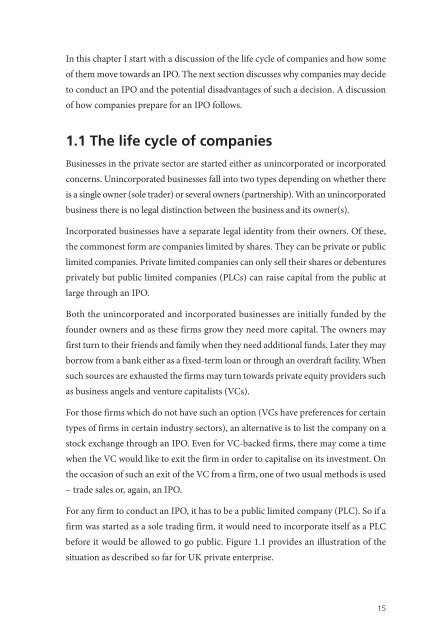Read a PDF Sample of Initial Public Offerings - Harriman House
Read a PDF Sample of Initial Public Offerings - Harriman House
Read a PDF Sample of Initial Public Offerings - Harriman House
Create successful ePaper yourself
Turn your PDF publications into a flip-book with our unique Google optimized e-Paper software.
In this chapter I start with a discussion <strong>of</strong> the life cycle <strong>of</strong> companies and how some<br />
<strong>of</strong> them move towards an IPO. The next section discusses why companies may decide<br />
to conduct an IPO and the potential disadvantages <strong>of</strong> such a decision. A discussion<br />
<strong>of</strong> how companies prepare for an IPO follows.<br />
1.1 The life cycle <strong>of</strong> companies<br />
Businesses in the private sector are started either as unincorporated or incorporated<br />
concerns. Unincorporated businesses fall into two types depending on whether there<br />
is a single owner (sole trader) or several owners (partnership). With an unincorporated<br />
business there is no legal distinction between the business and its owner(s).<br />
Incorporated businesses have a separate legal identity from their owners. Of these,<br />
the commonest form are companies limited by shares. They can be private or public<br />
limited companies. Private limited companies can only sell their shares or debentures<br />
privately but public limited companies (PLCs) can raise capital from the public at<br />
large through an IPO.<br />
Both the unincorporated and incorporated businesses are initially funded by the<br />
founder owners and as these firms grow they need more capital. The owners may<br />
first turn to their friends and family when they need additional funds. Later they may<br />
borrow from a bank either as a fixed-term loan or through an overdraft facility. When<br />
such sources are exhausted the firms may turn towards private equity providers such<br />
as business angels and venture capitalists (VCs).<br />
For those firms which do not have such an option (VCs have preferences for certain<br />
types <strong>of</strong> firms in certain industry sectors), an alternative is to list the company on a<br />
stock exchange through an IPO. Even for VC-backed firms, there may come a time<br />
when the VC would like to exit the firm in order to capitalise on its investment. On<br />
the occasion <strong>of</strong> such an exit <strong>of</strong> the VC from a firm, one <strong>of</strong> two usual methods is used<br />
– trade sales or, again, an IPO.<br />
For any firm to conduct an IPO, it has to be a public limited company (PLC). So if a<br />
firm was started as a sole trading firm, it would need to incorporate itself as a PLC<br />
before it would be allowed to go public. Figure 1.1 provides an illustration <strong>of</strong> the<br />
situation as described so far for UK private enterprise.<br />
15
















